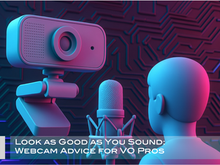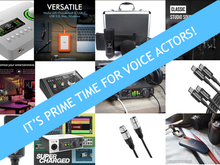Myth Busting: Noise- Causes & Solutions!
- Frank Verderosa
- Apr 17, 2023
- 4 min read
Updated: Sep 11, 2023

There are a handful of recording myths shared by voice actors that keep rearing their ugly heads, so I thought it might be nice to put them to bed as best I can. Among the most pervasive is the idea that you can record at a low level to reduce background noise. The logic seems solid. As someone recently said to me "I keep my recording level low so I don't hear all the noise in my headphones". The problem is, that doesn't actually do anything. In fact, turning your gain down and then turning it back up by normalizing actually degrades your sound by not taking full advantage of the available bandwidth in the digital domain. And that noise you didn’t hear is fully audible to anyone listening.
So what do I do about background noise?
Engineers have a saying: shit in equals shit out. You can't polish a turd. As coarse as that sounds, it's absolutely true. If you're aware of noise in your recording space, you need to address it before recording. Very few voice actors are able to completely soundproof a space in their home or apartment. Let's look at some common situations and problems:
Location

Folks in major cities tend to have much more noise to deal with that folks in the suburbs (at least until landscaping season). Anyone who's ever done a 15 minute evaluation with me has seen the live spectrogram of their audio file. Without fail, folks in major cities have a very pronounced low energy buildup that is the cumulative effect of subways, busses, trucks and other traffic down below. Shock mounts seem to have little effect on this in home studios. The GOOD news is that it's also generally not audible! For me to hear it, I'd have to feed it to my subwoofer. Often times actors are told to apply a roloff/ high pass filter if it's available on their mic. However, many lower cost mics don't offer this- which is a good thing, because the ones that do tend to do a horrible job of it. When I consult with actors that are using a decent mic and their voice is lacking warmth and bottom, it's often because they either chose to engage the filter... or worse, someone that should know better told them to. For what it's worth, it's not just the cheaper mics that are problematic. One large animation company asks for a roloff below 100 hertz- but asks that it NOT be done at the mic (a U87). They prefer it be done via Pro Tools/ DAW.

Folks out in the country might find themselves dealing more with chirping birds or nearby highway traffic, but the biggest issues are leaf blowers and lawnmowers. The only solution for those issues is waiting (not an option for directed sessions) or properly sound proofing your booth (or purchase a Studiobricks booth or similar).
Most noise removal tools are great at minimizing or eliminating consistent sound- what we might describe as “air”. But variable sounds like leaf blowers, lawnmowers, sirens or passing jets is nearly impossible to fix because of how they change frequency over time. If these are your issues- it’s going to keep you from getting booked (unless you happen to be in the same city as the recording studio that’s handling the job. Then you should be able to use their booth).
Proximity to appliances.
One frequent noise factor is appliances, especially in smaller apartments. Air conditioning, a nearby refrigerator, dishwasher, laundry, etc. These noise sources get us out of the low rumble zone and into the higher frequency stuff that's noticeable to the average listener. On a spectrogram, you can see this as a blanket of energy extending into the mid range frequencies. At very moderate levels, this is noise that's easily removed with plugins like RX Voice DeNoiser. However, voice actors experimenting with that tool tend to overdo it and make their sound worse. And while hiring an outside engineer to set that up for you seems like a good idea, that has proven disastrous time and again. If you’re doing the kind of work that requires finished audio to be delivered, and feel you need to learn to remove noise, keep an eye on my events page. I’ll be teaching a noise removal class covering RX up to version 9.

Computer noise.
The number one cause of booth noise is your computer. While firing up your laptop for a quick audition is generally quiet, once you’ve been running it for a while, that fan will kick on. Factor in Source Connect, Zoom and other power-hungry connectivity apps, and that fan will kick on much quicker! So how do you address this?
Some folks resort to quaint solutions like ice packs under their laptop- but the pro solve is to get that computer out of the booth entirely (or upgrade to a fan-less model like certain Macs with M1 or M2 chips. Do your research! They’re not all fan-less!). Getting the computer out of the booth can be as easy as setting it just outside the booth for a Source Connect session where you may not need to be on camera. Once your level is set and you’re up and running, just get the machine out of the recording space and go!
If you need to see your computer or have access to your DAW, then the solution is a separate computer display along with a Bluetooth keyboard and mouse. If you’re a Mac user with an iPad, you might be able to use the tablet as a second at display using just a cable from the laptop to the iPad!

Mind the gap!
If you’ve ever had a coach teach you that “hang ten” hand gesture as a distance to be from the mic- please forget you ever heard it. The fact is, at best it’s a ballpark position in a proper booth, but downright damaging in most home setups- even high-end ones like Studiobricks booths. There are two reasons why.: having too much distance between you and the mic leaves more opportunity for noise to get in, and also reveals the acoustic flaws inherent in small home booths (see my post about booth acoustics). At the same time, don’t get TOO close, because extreme proximity effect and plosives can become problematic.
If you’re not sure about your sound, I’m happy to listen. I’ve consulted with thousands of actors, and a 15 minute evaluation session can fix or address major issues.




























Comments